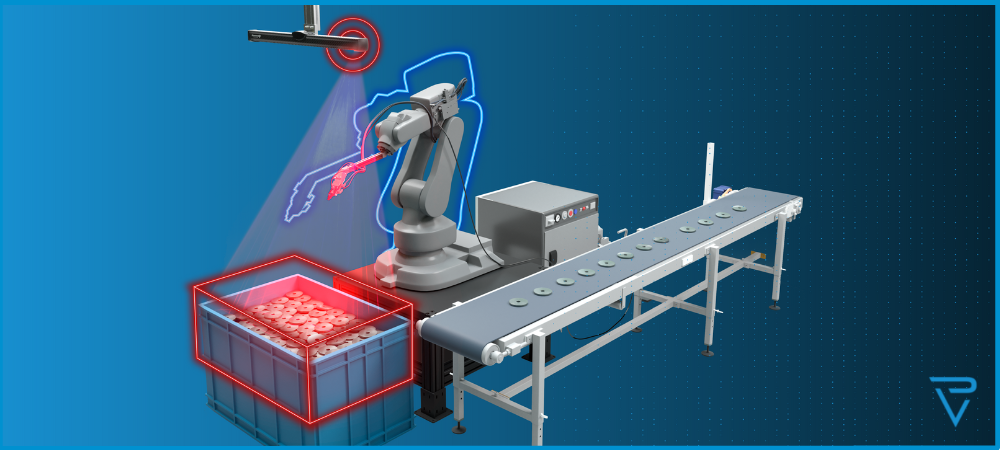
Improving efficiency through automation
Efficiency is a key factor in the success of any business. The faster a task can be completed, the more competitive a company can be in the market.
In this article, we will explore how efficiency can be improved through automation across various industries.
What is automation?
Automation is the use of technology to minimize human intervention, especially in processes that include repetitive tasks. With the rise of technological advancements, many industries have begun to adopt automation solutions, the most common applications including manufacturing, inspection and quality control, object handling, assembly, bin picking, and others.
Automation can take many forms, from basic repetitive tasks to advanced processes that require complex algorithms and machine learning.
There are several types of automation:
1.) Fixed automation (also called hard automation) – this type of automation is used for a single, fixed set of repetitive operations. These types of applications are usually simple, being programmed by commands. This type of automation is best suited for the production of generic products with high demand.
2.) Programmable automation – this type of automation allows changing the sequence of automation through reprogramming to respond to changing production needs. It is often used by factories that make different variants of foods in batches.
3.) Flexible automation (also called soft automation) – this type of automation is more complicated than programmable automation. It is best suited for the production of large varieties of products with constant changes and medium demand.
4.) Integrated automation – total automation with minimum human involvement. This type of automation is a good option for continuous process manufacturing and batch process manufacturing.
Which industries benefit from automation the most
While automation is spreading fast across sectors, the extent of benefits may vary depending on the specific industry, the complexity of tasks, and the availability of technology.
The industries that benefit the most from automation are those that involve repetitive or dangerous tasks, high volumes of data, and tasks that require high precision and accuracy. The most common sectors that deploy automation include manufacturing, inspection and quality control, automotive, logistics and warehousing, agriculture, food processing, or healthcare. However, any industry can benefit from the endless potential of automation.
While some industries, such as manufacturing, have been using automation for decades, others, such as healthcare, have only recently started implementing it. For instance, Photoneo’s 3D camera MotionCam-3D can be used to scan the whole body or a specific body part and the 3D model can be used in high-precision surgery.

Logistics is another sector that has experienced a significant boom in automation. The ability of MotionCam-3D to capture fast moving objects creates countless new possibilities for automation in the logistics sector. Such applications include order fulfillment and parcel sorting, palletization and depalletization, picking of items from shelves, dimensioning, and many others.
The cost of automation solutions can vary widely depending on the complexity of tasks, the technology used, the scope of the project, and the size of the company. Some automation solutions can be easily integrated into existing systems and workflows, without requiring significant customization or high implementation costs. Ultimately, the benefits of automation should outweigh the initial costs in the long run.
How to identify areas that are suitable for process automation
Identifying areas that are suitable for process automation involves a careful analysis and evaluation of the current processes, tasks, and workflows within an organization. By identifying areas that can benefit the most from automation, organizations can improve efficiency, productivity, and quality while reducing costs and errors.
The most common types of tasks that get automated are those that are repetitive, time-consuming, dangerous, prone to human error, or those that require high accuracy and efficiency. For instance, the monotonous and repetitive task of picking parts from a container can be done with Photoneo’s robotic intelligence tool Bin Picking Studio or, in collision-free environments, with the Locator Studio.
Cost and ROI evaluation is key here as customers need to consider both the upfront cost of implementing automation as well as long-term benefits such as increased efficiency, productivity, and quality.
Customers should prioritize areas for automation based on the potential benefits, ROI, and feasibility of implementing automation solutions, starting with areas that have the highest potential for improvement and move on to other areas as resources become available.
Implementing automation to increase efficiency
Implementing automation requires careful planning and execution. The process includes the following stages:
1.) Identifying the process to be automated
2.) Defining goals and objectives of automation, including the expected outcomes, such as increased productivity, efficiency, or accuracy
3.) Selecting the appropriate automation technology, including feasibility studies
4.) Setting up the solution
5.) Testing and validation
6.) Implementation
7.) Continuous monitoring to refine and optimize the solution
How to measure automated process efficiency
Measuring automated process efficiency is critical to determine the success of the automation process. It requires tracking KPIs (Key Performance Indicators) and analyzing data to determine the impact of automation on productivity, costs, and satisfaction.
Some of the KPIs that can be used to measure automated process efficiency include cycle time, error rate, throughput, accuracy, reliability, and cost savings. By monitoring KPIs and making adjustments as needed, organizations can continuously improve the efficiency of automated processes.
Benefits of automation
The benefits of automation are numerous. Automation can reduce the time required to complete a task, resulting in increased efficiency and productivity. Additionally, automation can reduce errors, decrease costs, increase employee safety, and improve customer service. By automating repetitive tasks, employees can focus on higher-level tasks, resulting in increased job satisfaction and employee retention.
Automation is a powerful tool that can improve efficiency and productivity across all sectors. Identifying areas that are suitable for automation and selecting the appropriate technology can result in significant benefits for a company. By implementing automation carefully and monitoring it continuously, companies can take advantage of the benefits that automation provides and gain a competitive edge in the market.
Would you like to discuss automation possibilities for your project with us? Contact us, we will be happy to talk to you.


